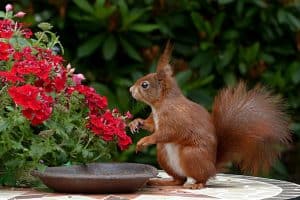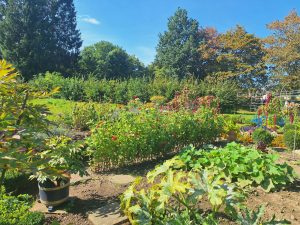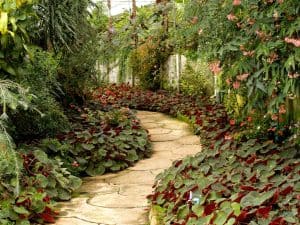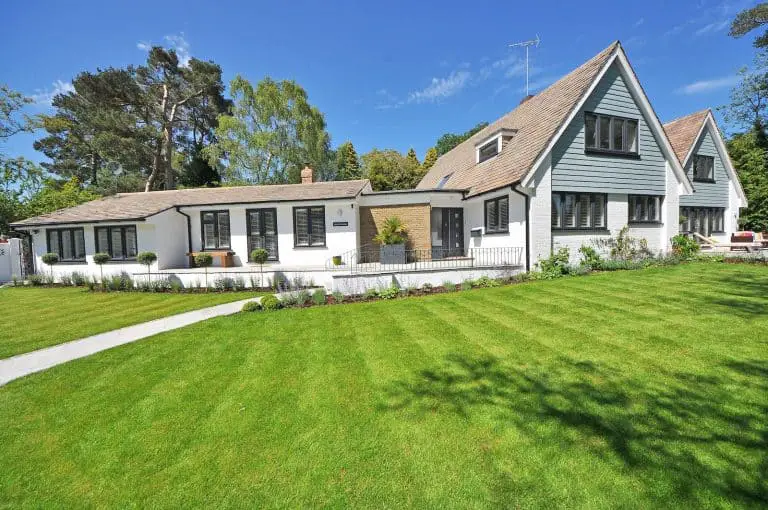Transforming your outdoor space into a haven for local fauna is more than just a trend—it’s a movement towards sustainability and environmental stewardship. That’s why I’m passionate about backyard wildlife-friendly landscaping, a method that not only beautifies your yard but also supports the intricate web of life right outside your door.
In this article, I’ll guide you through the essentials of creating a living landscape that invites birds, butterflies, and other wildlife to flourish. We’ll explore how simple changes like planting native species and providing food, water, and shelter can make a big impact. So whether you’ve got a sprawling garden or a modest patch of green, you’re on the right path to making it a wildlife oasis.
Choosing Native Plants

When we talk about backyard wildlife friendly landscaping, it’s essential to highlight the backbone of any habitat-friendly garden design: native plants. Creating a biodiverse backyard starts with understanding what local flora can offer. These plants have evolved in my area and are aptly suited to its climate, meaning they’ll thrive with less fuss.
Native Plant Species Fuel Wildlife Habitat
Incorporating native plant species isn’t just a horticultural choice; it’s a deliberate step towards forming a sustainable wildlife habitat. I’ve discovered that native greenery requires fewer chemicals and less water, which makes for a healthier environment for both flora and fauna. It’s not just about saving time and resources—though that’s a huge perk—it’s also about offering the best natural food sources for native wildlife.
With the National Wildlife Federation promoting environment-friendly practices, creating a certified wildlife habitat right in my yard becomes a realistic goal. Here’s what I’ve learned about selecting the right plants:
- Always purchase native plants that are indigenous to my region.
- Ensure the plants I choose can provide food and shelter for various wildlife species, including birds, butterflies, and small mammals.
- Avoid invasive plants that can outcompete native species and harm the local environment.
Attracting Wildlife to Backyard with Local Flora
Attracting wildlife to my backyard is a rewarding venture. Having a backyard wildlife friendly space means that I get to enjoy the sight of birds flitting among the trees and shrubs, monarch butterflies floating through a butterfly garden, and different species that find refuge in this mini-ecosystem. To specifically attract butterflies and cater to adult butterflies, I ensure that the plant selection provides both nectar and host plants for their larvae.
Creating a wildlife-friendly yard isn’t just about what plants I include but also about the structures I build. For example, bat houses become an invitation to these nocturnal mammals that eat insects, while bird feeders stocked with bird seed can supplement native food sources. Even simple measures like leaving a brush pile or some dead trees in place can create vital habitats.
Creating Sheltering Spaces
When planning a habitat-friendly garden design, one of the most crucial elements is creating sheltering spaces for backyard wildlife. These refuges not only serve as protection from predators and inclement weather but also offer crucial breeding grounds for various wildlife species.
Backyard Wildlife-Friendly Landscaping

Implementing backyard wildlife-friendly landscaping is all about increasing plant structure in your garden. This means incorporating trees, shrubs, and other plants that offer different levels of cover and forage for wildlife. By attracting wildlife to backyard settings with a mix of ground cover, mid-height bushes, and tall trees, you’re essentially mimicking the natural layers found in wild areas.
Native Plants: The Cornerstone of Wildlife Habitat
Choosing native plants is fundamental to any wildlife-friendly garden. These plants have evolved alongside local fauna, thus providing the best support. Native plant species are often hardy and require less maintenance. I’ve learned that once established, they’re better at withstanding local pests and extreme weather. Moreover, they help create a biodiverse backyard landscape that supports a wide array of wildlife habitat needs.
For instance, native plant species like milkweed are crucial for monarch butterflies, providing food for caterpillars and nectar for adults. Similarly, berry-producing shrubs may provide natural food sources for birds, while flowering plants like coneflowers and black-eyed Susans attract butterflies and other pollinators.
Brush Piles and Dead Trees: Essential to Native Wildlife
It’s not just about living plants. Features like brush piles create habitat nooks for small mammals, reptiles, and insects. Even dead trees, or ‘snags,’ play an integral part as they offer hollows for nesting birds and bats. In addition to using fallen tree limbs and leaves to create brush piles, I’ve also found that leaving parts of the yard undisturbed promotes a wildness that benefits native wildlife tremendously. These undisturbed areas provide cover, potential nest sites, and a variety of food sources.
Providing a Water Source
When creating a wildlife habitat in your space, incorporating a water feature is essential. Not only does it offer an aesthetic appeal, but it also plays a critical role in forming a biodiverse backyard landscape. I’ve discovered that even a simple bird bath can become a vital water source for different species.
Water is a fundamental need for all creatures, and in areas like the arid West, it’s often a scarce resource. By adding a water feature to my yard, I’m Attracting Wildlife to Backyard settings, giving them a place to drink and bathe. In my experience, anything that Provides Food and water sees increased visits from local fauna.
Backyard Wildlife-Friendly Landscaping
Through Habitat-Friendly Garden Design, we can support the local ecosystem while enjoying the company of native birds and other insects. I’ve found that the placement of the water feature should mimic natural conditions as closely as possible for it to become part of a thriving wildlife friendly yard.
Native Plants and Water Features
The synergy between native plant species and water features cannot be understated. While the plants offer Natural Food Sources, the water feature provides the necessary element for wildlife species to thrive. I’ve always encouraged friends to purchase native plants as they coalesce perfectly with natural water sources like ponds or streams, crafting a more effective and Backyard Wildlife Friendly Landscaping.
Embracing the Local Environment
Creating a wildlife habitat doesn’t mean you need to overhaul your entire garden. I started small: a bird bath here, a native shrub there. Over time, I’ve seen my unassuming outdoor space transform into a haven for native wildlife. A butterfly garden here and a brush pile there, and you’ve got a recipe for an inviting backyard wildlife friendly haven.
By gradually increasing plant structure and adding water features, my yard has become a certified wildlife habitat, something I’d recommend to anyone looking to give back to the Local Environment while enjoying the pleasures of a vibrant, nature-filled outdoor space.
Attracting Birds and Butterflies

Creating a Backyard Wildlife-Friendly Landscaping plan that’s both beautiful and beneficial for local fauna doesn’t have to be challenging. My experience with Habitat-Friendly Garden Design has taught me that the key is focusing on Attracting Wildlife to Backyard areas through intentional choices that foster a Biodiverse Backyard Landscape.
Native Plants: The Foundation of Wildlife Habitat
One of my first steps in Attracting Wildlife to My Backyard was to Purchase Native Plants. This move transformed my outdoor space into a flourishing Wildlife Habitat. Here’s why Native Plant Species are so crucial:
- Native Plants provide Natural Food Sources for wildlife.
- Native greenery has evolved with local Wildlife Species, making them perfect fits for each other’s needs.
- They’re more resistant to local pests, reducing the need for Broad Spectrum Pesticides.
When I replaced my Manicured Lawn with a mixture of trees, shrubs, and flowering plants native to my region, I began to see a marked increase in Different Species visiting my backyard. Birds, Butterflies, and even Small Mammals became regular sights. This transformation encourages a more dynamic Plant Structure essential for Certified Wildlife Habitat status through the National Wildlife Federation.
Building Blocks of a Butterfly Garden
Butterflies specifically seek out areas where they can find food both as caterpillars and as Adult Butterflies. The Butterfly Garden in my yard consists of:
- Milkweed for Monarch Butterflies
- Purple coneflowers and asters to Attract Butterflies of various kinds
- Non-invasive flowering plants that also provide food for other pollinators
Backyard Features That Benefit Wildlife
In addition to planting, certain features are foundational for a Backyard Wildlife-Friendly Landscaping project:
- Water Features: A simple Bird Bath can quench the thirst of numerous Wildlife Species. More elaborate water features like ponds create even richer Wild Areas.
- Brush Piles and Dead Trees: These elements offer necessary shelter and breeding grounds for various species.
Maintaining a Wildlife-Friendly Garden

Creating a habitat-friendly garden design is more than just a landscaping project; it’s a commitment to support the ecosystem. I’ve learned that maintaining a wildlife-friendly garden requires patience, observation, and a bit of know-how. Here, I’ll share tips to keep your backyard habitat bustling with life year-round, catered to those who are dedicated to attracting wildlife to their backyard.
Backyard Wildlife-Friendly Landscaping
To promote biodiverse backyard landscapes, native plants are essential. They provide natural food sources and cover for native wildlife species. I make it a priority to purchase native plants from local nurseries to ensure they’re suited to my local environment. These plants have evolved alongside the local fauna, making them a perfect fit for a wildlife habitat.
I actively avoid non-native plants which can become invasive and outcompete the necessary native species. By fostering a biodiversity of plants, my garden becomes an inviting outdoor space for different species. Brush piles and dead trees are conservation tools I use, as they create rich habitat structures for small mammals and birds to nest and feed.
Implementing Plant Structure
Increasing plant structure plays a critical role in transforming my garden into a haven for wildlife. Trees shrubs, herbaceous plants, and groundcovers lay the foundation of a living architecture that hosts a myriad of creatures. Tall trees provide shelter for birds, while shrubs may be the favorite nesting sites for some species. Groundcovers offer protection for amphibians and insects. It’s not just about what’s on top, but also what lies beneath: a healthy soil ecosystem supports a wealth of underground life.
Creating a Food Web
In my wildlife-friendly yard, I focus on plants that can provide food throughout the seasons. Berries, nuts, and seeds are on the menu, and I supplement these with bird feeders filled with bird seed, especially during the leaner months. For insects like monarch butterflies and other pollinators, I ensure my butterfly garden has nectar plants for adults and host plants for larvae. Bat houses offer safe roosting spots for these natural pest controllers who eat insects by the thousands, and bird baths offer a water source for all visitors.
Takeaway
Crafting a backyard that welcomes wildlife is a rewarding endeavor that not only benefits nature but also enriches my own living space. I’ve shared how simple additions like native plants and water features can make a significant impact. Remember it’s about creating an ecosystem where creatures can flourish. Whether you’re looking to certify your garden or just enjoy the presence of nature’s visitors nurturing a wildlife-friendly landscape is a step towards preserving our natural world. Let’s embrace the joy of watching a diverse range of wildlife right from the comfort of our homes.

